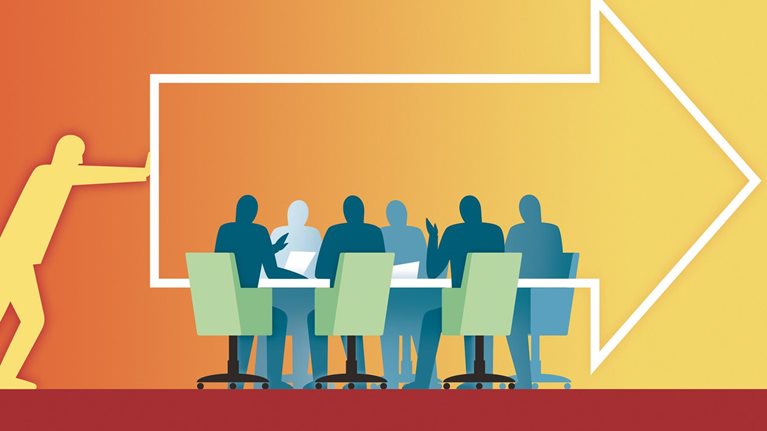
In 2017, the mayor of Nashville, Tennessee, proposed spending up to $9 billion on a mass-transit system, including 26 miles of light rail. Voters rejected the plan the following year. One reason for this outcome: people questioned whether it made sense to spend big money, for decades, on traditional transit when mobility technologies were changing so quickly.1
Nashville is hardly the only city where people ask such questions. Even so, investment in light-rail and metro systems is massive. By 2025, we estimate, cities and rail operators will spend nearly $100 billion on new rolling stock.2 Over that same period, we estimate they will break ground on at least $1.4 trillion in new light-rail and metro projects (Exhibit 1). Asia accounts for two-thirds of the spending on construction: for example, Beijing, Kuala Lumpur, Shenzhen, and Singapore are all building at least one rail project with a value of more than $5 billion.3
The case for building new rail is strong. The main attraction is enormous efficiency. By 2050, an additional 2.5 billion people will be living in cities, and rail can move more people than any other kind of transportation. Today, one metro line can carry more than 70 times as many passengers as a city street with cars. In the future, a new metro line would carry more than 12 times as many, even if vehicles were shared, smaller, and swift (Exhibit 2).
Rail has other advantages too. If it is electrified, it emits neither greenhouse gases (such as carbon dioxide) nor smog-causing pollutants (such as nitrous oxide or sulfur dioxide). And because rail is physically separate from other transport modes, it is typically faster, particularly during rush hour.

New uncertainty
There is, however, a disadvantage to rail projects: they are expensive and take a long time to complete. Successful planning therefore requires looking into the future—even though no one knows how the global mobility system is going to evolve.
New modes of transport are changing how people get around. “Micromobility” in the form of electric scooters and shared bicycles, for example, can convert a 30-minute walk into a ten-minute ride. And change can happen fast; consider how quickly people took to using their smartphones to hail cars. In the future, self-driving taxis (or “robotaxis”) could offer people the convenience of e-hailing at a price similar to the cost of driving their own cars.4
Such technologies could take passenger traffic away from rail. A recent survey by the McKinsey Center for Future Mobility found that 35 percent of Europe’s e-hailing passengers and 20 percent of those in the United States had switched from rail.5 Depending on how robotaxis are regulated, they could put another dent in rail ridership as travelers choose door-to-door options.6
If a significant share of passengers gave up rail, operators would feel the consequences. In New York, for example, the competition from e-hailing, together with other factors (such as poor service levels), caused the city to lower its forecast for subway ridership by nearly 10 percent from 2015–19 and has cost hundreds of millions of dollars in lost revenue.7 Such declines might force operators to increase fares or decrease service, driving away even more passengers and worsening street congestion.
On the other hand, new technologies could also help rail attract more passengers by making it easier for people to take transit: for example, in April 2018, Didi Chuxing, the Beijing-based e-hailing–transport-services giant, with a platform of some 550 million users, announced a new function that supplies public-transportation options in combination with its ridesharing services. Lyft is running pilots with cities in California, Colorado, and Florida to provide subsidized first–last mile connections to transit stops.8 Many similar projects are under way around the world.
So it’s complicated. Operators and city leaders need to consider the impact of new technologies and to figure out how they can be integrated into mobility planning—an issue that came up in Nashville. But this does not appear to be happening. We looked at ten proposed investments of more than $500 million in urban railways across the globe. Of these, only one even mentions the possible effects of autonomous vehicles on transit ridership.9
Moving beyond uncertainty: How to shape the system
The next few decades will be pivotal. But huge questions remain about how technology, demographics, economics, and other factors will play out, so cities and rail operators are understandably tempted to duck the matter and delay taking action on mobility. If they do, however, they may find themselves playing an expensive game of catch-up to build infrastructure that works in concert with new technologies. By 2030, according to previous McKinsey research, forms of transport that don’t currently exist could serve as much as 40 percent of today’s transportation-revenue pool.10
The idea of “seamless mobility” offers a future vision that can guide action now. McKinsey, which has written several reports exploring this topic,11 defines seamless mobility as systems incorporating the use of different kinds of transit and enabled by technologies such as intelligent traffic systems and advanced rail signaling. Seamless mobility makes transportation systems cleaner, cheaper, more accessible, and more convenient than they are today.12 In addition, infrastructure would be used with greater efficiency, accommodating a 30 percent increase in traffic while cutting travel times by 10 percent.13
Although the specifics will vary from place to place, the following four steps can help cities and rail operators work together to shape systems toward seamless mobility.
Set aspirations
To get started, stakeholders need to agree on where they are going. Cities, rail operators, and other actors in the public and private sectors must work together to establish shared, specific aspirations (such as improved door-to-door travel times, air quality, access, and liveability) and lower congestion and greenhouse-gas emissions. Hamburg, Germany, for example, plans to have some kind of public-transportation option within five minutes of anywhere in the city by 2029.14 To meet that goal, dense cities will generally have to use sharing and mass transit more extensively. Suburbs and spread-out cities could incorporate a high degree of private transit, such as cars—preferably electrified (via renewable sources) and autonomous. Remote areas could use on-demand services.
Build a master plan based on a ‘digital twin’
To meet their aspirations, cities and rail operators need to understand how evolving demand and technologies could affect a system’s operations. One approach is to create a digital twin of the mobility system. This would combine new geospatial-modeling techniques with publicly available data to simulate how millions of commuters would reconsider their choices as transit systems change.
This kind of modeling can form the basis of a master plan for an entire mobility system, not just transit networks. Such a plan could include a coordinated set of complementary investments and policy changes: a new rail line, for example, could become more attractive if housing were developed near its stations. Congestion pricing might be more successful coupled with investments in convenient, accessible, and fast public transport. Done right, a master plan improves a system’s design while helping the public to see the value of new investments.
Decide how to enhance and expand infrastructure
Cities differ among themselves, so different places will make different choices, depending in particular on population density and expected population growth.
In sprawling, slow-growing cities—think of Cleveland, Ohio, or Birmingham, England15—it might make more sense to invest in road-based technologies (such as bus rapid transit or, eventually, autonomous shuttles) than to build new rail and metro lines. This is a rule of thumb, however, not a scientific principle; specific circumstances might point to a different decision. Los Angeles, for example, wants to make its downtown denser and to ease congestion, so it is investing in new rail to achieve both goals.16
In dense, slow-growing cities, such as New York or Hong Kong, by contrast, rail is likely to continue to be essential for urban-mobility systems. As long as that holds true, cities and rail operators must invest in them to maintain quality and to compete as other kinds of mobility emerge.
Finally, in dense, fast-growing cities, such as Abu Dhabi or Ho Chi Minh City, urban rail systems will need to expand, since they move people faster and more efficiently than any other form of ground transit.
In every case, cities should train their focus on projects that can adapt as technology evolves. One way is to design projects flexibly; for example, rail stations that connect with autonomous-shuttle services and offer space for bikes or e-scooters can help to manage uncertainty. Another is to redesign contracts in a way that reduces risks to cities. Design–build–operate–maintain agreements, for example, can link ridership with payments to third parties: if fewer passengers use the system, the city pays less. And instead of placing bulk orders to replace rolling stock, rail operators could consider spreading out their acquisitions, reserving the right to cancel or to change specifications along the way.
Establish partnerships with mobility operators
New mobility options are already becoming a bigger part of the transportation fabric, from bicycle-sharing docks at train stations to e-hailing vehicles that provide access to places traditional bus services do not reach. Partnerships with these and other entities can help transit operators to gather data and position themselves for the future.
One possibility is to create a single interface that passengers can use to plan and pay for their trips, whether by rail, bus, e-hailing, scooters, or shared bicycles. Such “mobility as a service” offerings would make the companies that developed them the gateway to the entire system. This role would allow cities or rail operators to continue influencing the mobility system as it evolves.
New kinds of transport and technology are injecting unprecedented uncertainty into mobility planning. Some broad trends, however, can be predicted with reasonable confidence. Among them:
- Passengers will behave in new ways and have new expectations.
- Companies will base new offerings on innovation and regulation.
- New developments will reshape the physical character of some cities.
We believe that cities can respond to these trends and achieve equitable access to transit, fast com-mutes, low emissions, and pleasant streets. This is a tall order. But recall that in the late 1800s, residents of cities were just as worried about the environmental and health consequences of horse-dominated traffic.17 Technology and innovation, in the form of the car and the rail system, dealt with that problem.
By looking forward, cities and rail operators can create a mobility system that meets the current challenge—and serves the passengers not only of this century but also the next.

